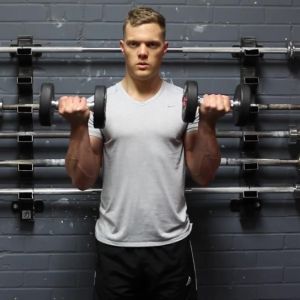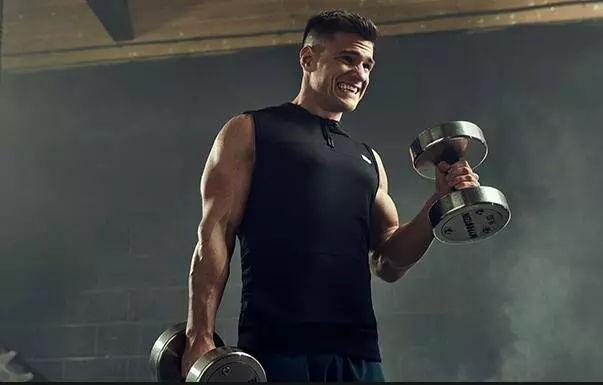Building a strong upper body goes beyond just biceps. The unsung heroes of arm day, your forearms, play a crucial role in everything from lifting weights to opening jars
Reverse curls are a powerful exercise that specifically targets the muscles of the forearms, helping you develop strength, size, and definition. While often overshadowed by traditional bicep curls, mastering the reverse curl technique can unlock a whole new level of forearm development.
Table of content
What is a Reverse Curls?
Reverse curls differ from traditional curls in that they target the brachioradialis muscle, located on the thumb side of the forearm. By gripping the barbell or dumbbells with a pronated (overhand) grip, the brachioradialis is engaged to a greater extent, making reverse curls an excellent exercise for forearm development.
Difference From Wrist Curls


Reverse Curls:
- Target: Brachioradialis (outer forearm), Brachialis (under biceps)
- Movement: Full elbow flexion, curling weight towards the shoulder
- Weight: Heavier weights due to larger muscles engaged
Wrist Curls:
- Target: Wrist flexors (underside of the forearm)
- Movement: Wrist flexion only, raising/lowering hand with weight
- Weight: Lighter weights due to smaller muscles
If your primary goal is to build stronger, more functional forearms with improved grip strength, reverse curls are the better choice.
If your primary goal is to build stronger, more functional forearms with improved grip strength, reverse curls are the better choice.
What Do Reverse Curls Work?
The muscles involved in reverse curls are:

Biceps- The biceps are often referred to simply as the biceps. The two starting points of the biceps are above the shoulders, and one insertion point is below the forearms. It is a biaxial muscle that passes through and affects two joints. The function of the biceps is:
- Shoulder flexion
- Elbow flexion
- Forearm supination
Brachioradialis-brachial is one of your main forearm muscles. The developed biceps can push your biceps outwards to form a more impressive upper arm. This will make your biceps look bigger, just "support" from below. The brachioradialis muscle works with the biceps to bend the elbow. It is also the forearm flexor.
Brachialis- Located below the biceps, the brachialis is another elbow flexor that is particularly active at the beginning of any curling exercise. Just like the brachioradialis muscle, it can push your biceps upwards to increase the size and shape of your arm
How to Do a Reverse Curl?
Now that you're convinced about the benefits of reverse curls, let's learn how to perform them with perfect form to maximize results and avoid injuries.
Here's a step-by-step guide:
- Equipment: You can perform reverse curls with dumbbells, a barbell (straight or EZ bar), or even a cable machine. Choose a weight that allows you to maintain proper form throughout the set.
- Starting Position: Stand tall with your feet shoulder-width apart and core engaged. Maintain a slight bend in your knees for stability.
- Grip It: Grab the weights with an overhand grip (palms facing down). For dumbbells, ensure your palms are facing each other. If using a barbell, a shoulder-width grip is ideal.
- The Curl: Keeping your elbows close to your sides, curl the weight up towards your shoulders. Focus on squeezing your forearms to lift the weight, not using momentum.
- Top It Off: At the peak of the curl, your forearms should be fully contracted and wrists slightly bent upwards. Hold this position for a second to maximize the contraction.
- Controlled Descent: Slowly lower the weight back to the starting position, maintaining control throughout the movement.
- Reps and Sets: Aim for 3 sets of 8-12 repetitions for optimal results. As you get stronger, you can increase the weight or reps.
Pro Tips for Perfect Reverse Curls
- Mind the Form: Don't swing the weights or use momentum to lift them. Focus on isolating the forearms and maintaining proper technique throughout the exercise.
- Elbows Locked In: Keep your elbows tucked in close to your body throughout the movement. This prevents unnecessary strain on your shoulders.
- Full Range of Motion: Aim for a full range of motion by completely lowering the weight at the bottom of the curl.
- Slow and Steady Wins the Race: Focus on controlled movements, both during the lifting and lowering phases. This ensures maximum muscle engagement.
- Breathe Easy: Breathe out as you curl the weight up and inhale as you lower it. Proper breathing helps maintain core stability and focus.
Reverse Curl Variations: Spice Up Your Workout
Ready to take your reverse curls to the next level? Here are some variations to keep your workouts interesting and challenge your forearms in different ways:
1.Seated Reverse Curls
Seated reverse curls are an excellent variation that targets the brachialis and brachioradialis muscles while providing added stability by being seated.
How to Do It:
Setup: Sit on a weight bench with your feet flat on the ground and your back straight. Hold a pair of dumbbells with an overhand grip (palms facing down) and arms fully extended down by your sides.
Starting Position: Ensure your elbows are close to your torso and your wrists are straight.
Execution: Slowly curl the dumbbells up towards your shoulders, keeping your upper arms stationary and focusing on using your forearm muscles.
Return: Lower the dumbbells back to the starting position in a controlled manner.
Tips:
- Control: Move slowly and deliberately to maximize muscle engagement and avoid using momentum.
- Range of Motion: Ensure you fully extend your arms at the bottom of the movement and fully flex at the top.
- Wrist Position: Keep your wrists straight throughout the exercise to avoid strain.
- Breathing: Exhale while curling up and inhale while lowering the weights.
- Reps and Sets: Perform 3 sets of 10-12 reps.
2.EZ Bar Reverse Curl
How to Do It:
- Setup: Stand with feet shoulder-width apart, holding an EZ bar with an overhand grip (palms facing down) and arms fully extended.
- Execution: Curl the EZ bar up towards your shoulders, keeping your elbows stationary and close to your torso.
- Return: Lower the EZ bar back to the starting position in a controlled manner.
Tips:
- The EZ bar's angled grips can reduce strain on the wrists.
- Perform 3 sets of 10-12 reps.
3.Cable Reverse Curl
How to Do It:
- Setup: Stand in front of a cable machine with a straight bar attachment set at the lowest pulley position, holding the bar with an overhand grip.
- Execution: Curl the bar up towards your shoulders, keeping your elbows stationary and close to your torso.
- Return: Lower the bar back to the starting position in a controlled manner.
Tips:
- The constant tension from the cable provides a different stimulus compared to free weights.
- Perform 3 sets of 10-12 reps.
4.Resistance Band Reverse Curl
How to Do It:
- Setup: Stand on the middle of a resistance band with feet shoulder-width apart, holding the ends of the band with an overhand grip.
- Execution: Curl the band up towards your shoulders, keeping your elbows stationary and close to your torso.
- Return: Lower the band back to the starting position in a controlled manner.
Tips:
- The resistance band provides variable resistance, increasing as you curl upwards.
- Perform 3 sets of 15-20 reps.
Benefits of Reverse Curls
Still not sure whether reverse curls should be part of arm exercises? These benefits should convince you!
Save time- because reverse curls exercise your biceps and forearms at the same time, they save you from having to exercise these muscle groups separately. If you don't have enough time, these arm training arms may be very popular.

Build stronger grip strength—Strong grip strength is an important part of successful strength training. Exercises such as deadlifts, rowing, and pull-ups can be painful. If your grip fails, your group may end suddenly and prematurely. A stronger grip will have a knock-on effect on the rest of your exercise, allowing you to lift heavier weights or do more representation.
Reduce elbow pain-The muscle imbalance between the forearm flexors and extensors can cause unpleasant elbow pain. By targeting the brachialis and brachioradialis muscles, reverse curls can repair any imbalance between the flexors and extensors, thereby eliminating common causes of elbow pain.
Building Your Reverse Curl Routine
- Frequency: Aim for 2-3 reverse curl sessions per week, spaced evenly throughout your upper body workouts.
- Placement: You can perform reverse curls as a warm-up exercise to activate your forearms before heavier bicep exercises, or as a finisher to fatigue the forearms after bicep work.
- Progression: As you get stronger, gradually increase the weight, reps, or sets to keep challenging your muscles. Consider drop sets or supersets with bicep curls to intensify the workout.
Troubleshooting Common Reverse Curl Issues

- Wrist Pain: This could indicate improper form. Ensure your wrists are slightly bent back at the peak of the curl and avoid hyperextending them. Lighter weights with proper form are better than heavier weights with compromised form.
- Limited Grip Strength: Start with lighter weights and focus on controlled movements. Consider incorporating grip training exercises like dead hangs or farmer's walks to improve overall grip strength.
- Not Feeling the Forearms: Ensure you're using proper form and squeezing your forearms to lift the weight, not using your biceps or momentum. You can also try variations like seated reverse curls or hammer curls for a different forearm activation.
FAQs
Are reverse curls better than wrist curls?
It depends on your goals. Reverse curls target a broader range of forearm muscles and improve grip strength, while wrist curls focus on the wrist flexors and improve wrist stability. You can combine both exercises for a well-rounded forearm workout.
What weight should I use for reverse curls?
Choose a weight that allows you to maintain proper form throughout the entire set (typically 8-12 repetitions). You should feel a challenge in your forearms without compromising form or using momentum.
Can I do reverse curls with dumbbells or a barbell?
Yes! Both dumbbells and barbells (straight or EZ bar) are effective for reverse curls. Dumbbells allow for more independent movement, while a barbell can help maintain proper form.
Can reverse curls cause pain?
If you experience pain during reverse curls, stop the exercise immediately. It could be a sign of improper form or an underlying injury. Ensure you use a weight that allows for proper control and consult a healthcare professional if the pain persists.
How can I incorporate reverse curls into my workout routine?
You can perform reverse curls as a warm-up exercise to activate your forearms before heavier bicep exercises, or as a finisher to fatigue the forearms after bicep work. Aim for 2-3 reverse curl sessions per week, spaced evenly throughout your upper body workouts.
Embrace the Reverse Curl and Build a Stronger, More Functional You!
Indeed, that’s why the reverse curl is as effective and versatile as any other exercise that should be included in your arm workout. By including this exercise together with focusing on correct mechanics, the viewer will have functional and phenomenal forearms for both strength training and generalized living. Well, be prepared to bring forth the sheer strength of your forearms and put your upper body to further superior workout sessions!






